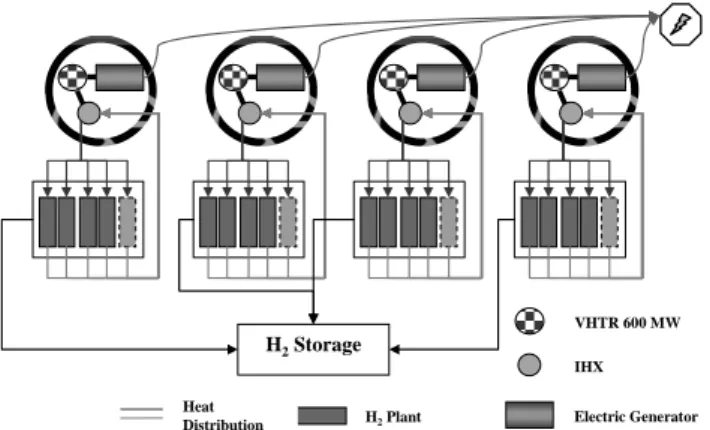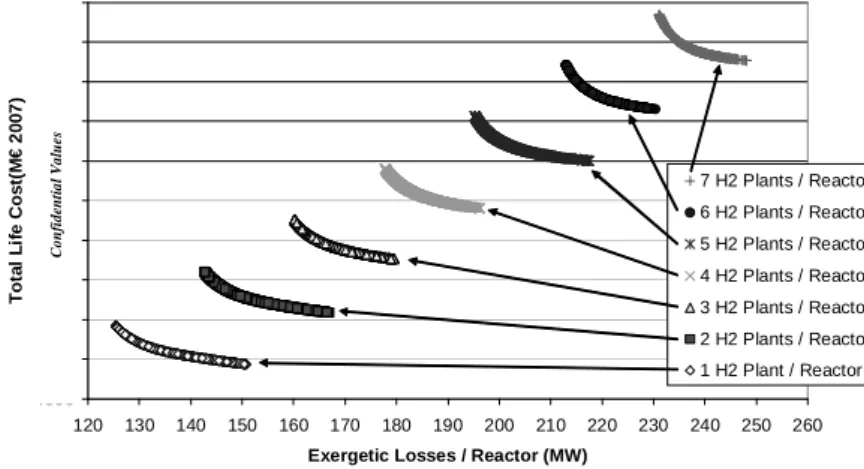O
pen
A
rchive
T
oulouse
A
rchive
O
uverte (
OATAO
)
OATAO is an open access repository that collects the work of Toulouse researchers and makes it freely available over the web where possible.
This is an author-deposited version published in: http://oatao.univ-toulouse.fr/ Eprints ID : 3049
To link to this article :
URL :
http://www.escape19.org/
To cite this version : Azzaro-Pantel, Catherine and Domenech, Serge and Dumaz,
Patrick and Gomez, Adrien and Haubensack, David and Latgé, Christian and
Pibouleau, Luc ( 2009) A MultiObjective Genetic Algorithm Framework for
electricity / hydrogen co-production from generation IV nuclear energy systems.
In: Escape 19, June 2009, Cracow,Pologne.
Any correspondence concerning this service should be sent to the repository administrator: staff-oatao@inp-toulouse.fr
A MultiObjective Genetic Algorithm Framework
for electricity / hydrogen co-production from
generation IV nuclear energy systems
Adrien Gomez a,c, Catherine Azzaro-Pantel a, Luc Pibouleau a,
Serge Domenech a, Christian Latgé b, Patrick Dumaz c, David Haubensack c
a
Université de Toulouse, Laboratoire de Génie Chimique, CNRS UMR 5503, 5 rue Paulin Talabot, 31106 Toulouse Cedex 1, France, {Adrien.Gomez,
Catherine.AzzaroPantel, Serge.Domenech, Luc.Pibouleau}@ensiacet.fr b
CEA Cadarache, DEN/CAD/DTN/DIR Bât 710, 13108 St Paul Lez Durance, France, Christian.Latge@cea.fr
c
CEA Cadarache, DEN/CAD/DER/SESI, Bât 212, 13108 St Paul Lez Durance, France, {Patrick.Dumaz, David.Haubensack, Adrien.Gomez }@cea.fr
Abstract
One of the great motivations of studying and developing Generation IV (Gen IV) reactors of VHTR (Very High Temperature Reactor) design is their capacity
to efficiently produce both electricity and H2 (hydrogen). This study aims at
developing an optimization methodology for cogeneration systems of hydrogen and electricity, with respect to energy constraints, economics and conjuncture in terms of demand. It lies within the scope of a collaboration between the Laboratoire de Génie Chimique (LGC Toulouse, France) and the French Atomic Energy Commission (CEA, Cadarache, France) in order to compare various cogeneration systems from both energy and economics viewpoints.This paper describes the different steps of the technico-economic methodology for
H2 and electricity cogeneration systems.
Keywords: Hydrogen, Electricity, cogeneration, Gen IV nuclear systems, multiobjective optimization
1. Introduction
Hydrogen is currently viewed as one of the energetic vectors that will replace
traditional fossil fuels in the XXIth century. Although the transition is assumed
to be progressive, innovative technologies for a massive production of H2 have
to be investigated.
The VHTR (Very High Temperature Reactor) concept, considered as the nearest-term reactor design, can indeed be coupled on the one hand, with
innovative electricity-generating cycles and, on the other hand, with massive H2
production processes. Thus, due to a high exit core temperature (at least 950°C) reached by helium used for cooling, VHTR is dedicated to the cogeneration of electricity and hydrogen by Sulphur-Iodine (S-I) thermochemical cycle or by High Temperature Electrolysis of steam water. Globally, these processes require the simultaneous supply of electricity and heat at high temperature. The optimal design of these process configurations constitutes an important challenge.
In this perspective, simulation tools for thermal systems were previously developed by the CEA (French Atomic Energy Commission, Cadarache, France), i.e., CYCLOP for thermodynamic cycle modelling. This code allows to model innovative energy production systems for given operating conditions while taking into account the influence of classical variables: exchanger efficiency, pressure ratio and isentropic efficiency (compressor, turbines …), pressure loss…
This paper first describes the three steps of the technico-economic optimization methodology implemented for the selection of cogeneration systems. The first one is based on a bicriteria optimization with total life cost and exergy losses minimization. The second one implies exergetic production cost evaluation of any energy form. The last step provides decisional data, as hydrogen production cost for different scenarios for electric market corresponding to a given plant, to make possible the choice between different systems. Finally, the methodology is applied successfully to two different systems dedicated to electricity and hydrogen production, taking into account various scenarios of the electricity market.
2. Technico-economic optimization methodology for H2 and electricity cogeneration
The choice of the best strategy for electricity and H2 massive production
systems is a technico-economic concern. The cogeneration system considered here (Fig. 1) consists in coupling a VHTR nuclear reactor with an electrical generator (that is a Brayton cycle) in direct cycle, on the one hand, and, with a hydrogen production plant (Iodine-Sulphur cycle) for which the thermal and electrical demand is known.
It involves a site of 4 autonomous sections, each one including a VHTR reactor,
H2Storage VHTR 600 MW IHX Electric Generator H2Plant Heat Distribution
Fig. 1. Configuration of electricity and H2 cogeneration site (example)
2.1. Bicriteria optimization by exergetic losses and lifespan cost minimization of the production plant
The first step of the methodology implies a bicriteria optimization, by simultaneous minimization of the total exergetic losses and of the total costs of the production sites over their lifespan.
The choice of a criterion based on the minimization of the exergetic losses was justified in [1]: it represents the lost “available work” during the energy conversion. The thermodynamic model of the cogeneration system is implemented in the CYCLOP simulator [2]. The economic criterion takes into account both construction costs of the site (nuclear reactors, electricity
generators, H2 plants) and operating costs (nuclear fuel, maintenance of VHTR
and H2 plants) for 60 years life (Eqn. 1):
D 1 t t Invest M & O Nucl.Fuel Site Ca t Ca t Ca t 1 i TC
(Eqn. 1.) Where:TCSite: Total Cost (M€), CaNucl. Fuel: nuclear fuel annual cost, CaO&M: operating &
maintenance costs, CaInvest.: investment annual cost (including end of life costs),
i: discount rate (%), D: Cogeneration Site Life (years)
The economic model, based on the so-called SEMER code [3], was extended
for H2/electricity cogeneration case and cost models for innovative components
were also developed specifically. The multiobjective optimization procedure was performed via genetic algorithms, that have proven to be particularly well-fitted for such problems and have the advantage to lead directly to the so-called Pareto front. The bicriteria optimization step was carried out with MULTIGEN library [4], as a master procedure, connected to CYCLOP and SEMER codes (Fig. 2).
MULTIGEN Algorithm(NSGA II)
CYCLOP
Thermodynamic Model
Global Optimisation Variables
Flows, pressure ratio, exchanger efficicency, …
SEMER
Economic Model of Cogeneration Site
Total Life Cost Over lifespan Component Cost Models Exergy Losses Of Cogeneration Site Optimization Criterion
Fig. 2. Integration of the different models in the methodology
Typical results are presented in Fig. 3 and exhibit different sets of compromise
solutions, called Pareto fronts corresponding to various H2 production levels
represented by one or several H2 production plants. The objective of the
following step of the methodology is to reduce this set to assist the decision maker in selecting the preferred or best compromise solution from among the whole set of solutions.
4500 5000 5500 6000 6500 7000 7500 8000 8500 9000 9500 120 130 140 150 160 170 180 190 200 210 220 230 240 250 260
Exergetic Losses / Reactor (MW)
T o tal L ife C o s t( M € 2 0 07 ) 7 H2 Plants / Reactorr 6 H2 Plants / Reactor 5 H2 Plants / Reactor 4 H2 Plants / Reactor 3 H2 Plants / Reactor 2 H2 Plants / Reactor 1 H2 Plant / Reactor Con fide n ti al V a lu es
Fig. 3. Bicriteria optimization results: Pareto fronts for cogeneration systems.
2.2. Global production cost evaluation
The production cost evaluation is classical for electricity production (Eqn. 2), and has been performed for the solutions identified at the first step of the methodology (Fig. 3).
D t t Site od i t Pa TC kWh C 1 Pr 1 1000 / (Eqn. 2.) Where:CProd: production cost (€/kWh), Pa: annual production of energy (MWh/year).
For cogeneration systems, the annual production of energy involves the
contribution of both electricity and exergetic power of H2:
W m 2 P H2H
Pa elec H Ex
(Eqn. 3.)Where:
H: production period (hours/year), Welec: electric production (MW),
2
H
Let us mention that the electrical and hydrogen production cost is identical in value (€/kWh) from an exergetic point of view. According to Fig. 4, solutions with minimum exergetic production costs can be highlighted: they correspond
to minimal production costs of electricity. But, at this level, H2 and electricity
are undifferentiated from the production cost point of view.
m : H2 production (mol/s), PEx: Exergetic Power of H2 (235.3 MJ/mol).
0,082 0,092 0,102 0,112 0,122 0,132 0,142 0,152 0 50 100 150 200 250 300
Electric Production / Reactor (MW)
E xer g et ic P ro d u ct io n C o st ( €/kW h ) 7 H2 Plants / Reactor 6 H2 Plants / Reactor 5 H2 Plants / Reactor 4 H2 Plants / Reactor 3 H2 Plants / Reactor 2 H2 Plants / Reactor 1 H2 Plant / Reactor Selected:
Minimum Production Cost solutions Co n fidential V a lu es
Fig. 4. Production cost evaluation for bicriteria optimization results
2.3. Fixing the cost of electricity
As abovementioned, the use of the exergy concept implies that the production costs of both forms of energy are undifferentiated, i.e. the overcost related to the
production of H2 is reflected on the cost of electricity. The production cost of
electricity (€/kWh) is then fixed to deduce the production cost of hydrogen
(€/kg). For a given H2/electricity production ratio, an optimum of H2 production
costs exists for a given electricity cost, as displayed in Fig. 5. These results constitute a decisional map for the selection of cogeneration systems. Each
optimal solution is related to a simultaneous electricity/hydrogen production: optimal production costs can be deduced from Fig 5.
0,0 0,5 1,0 1,5 2,0 2,5 3,0 3,5 4,0 4,5 5,0 0,00 0,05 0,10 0,15 Electricity Production Cost (€/kWh)
H 2 Pr od uc ti on C o s t (€ /k g ) 0 50 100 150 200 250 300 350 400 450 H 2 Pr od uc ti o n o f Si te ( T o n s /D a y ) H2 Cost (€/kg) H2 Production 0,0 0,5 1,0 1,5 2,0 2,5 3,0 3,5 4,0 4,5 5,0 0,00 0,05 0,10 0,15 Electricity Production Cost (€/kWh)
H 2 Pr od uc ti on C o s t ( € /k g ) 0 200 400 600 800 1000 1200 El ec tr ic P rod uc ti o n o f Si te ( M W) H2 Cost (€/kg) Electric Production Con fiden tial V a lu es Con fident ial V alu es
Fig.5. Final optimal cogeneration solutions for decision makers 3. Conclusions
The proposed methodology, based on classical evaluation criteria, makes it possible to visualize clearly and quickly the economic interest of cogeneration
systems (electricity & H2). From the application of exergetic theory, the overall
production cost can be deduced. When fixing the cost of electricity, different scenarios can be proposed to the decision maker to assist him for cogeneration system selection. This methodology is intended to be applied to any system, implying different modes of production for electricity and hydrogen.
4. References
[1] A. Gomez et al., Optimization of electricity / hydrogen cogeneration from generation IV nuclear energy systems, ESCAPE 17, Elsevier, 2007.
[2] D. Haubensack et al., The COPERNIC/CYCLOP Computer Tool: Pre-conceptual Design of Gen IV Nuclear Systems, Proceedings, Conf. on High Temperature Reactor, Beiging, IAEA, 2004.
[3] S. Nisan et al., SEMER: a simple code for the economic evaluation of nuclear and fossil energy-based power production systems, Nucl. Eng. and Design 221 (2003) 301.
[4] A. Gomez et al., Teaching Mono and Multi-objective Genetic Algorithms in Process Systems Engineering: an illustration with the MULTIGEN environment, ESCAPE 18, Elsevier, 2008.


